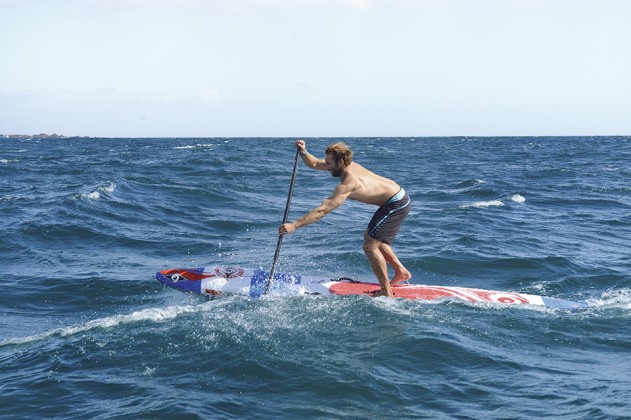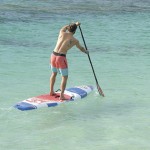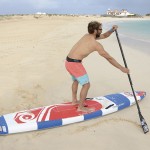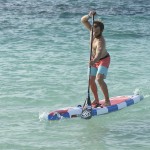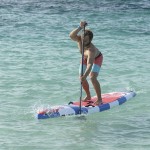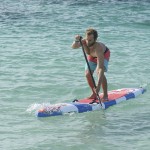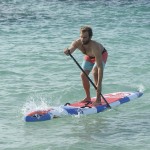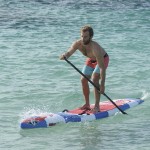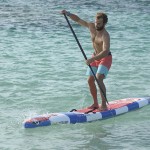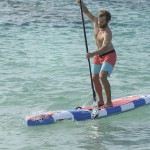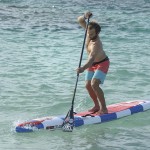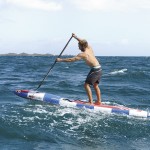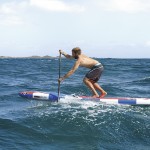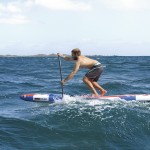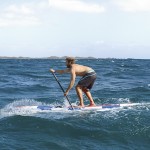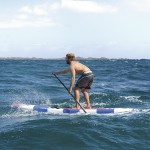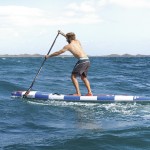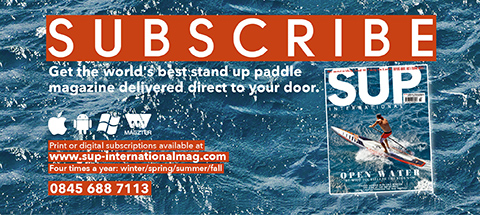OPTIMISE YOUR PADDLE EFFICIENCY IN DIFFICULT CONDITIONS, UPWIND
& SIDE WIND
Paddle board consultant – Eric Terrien
In contrast with flat or Downwind conditions, which give all riders a chance to appreciate the sensation of the smooth glide of their board, nobody really enjoys paddling into a headwind, or battling through a strong side wind that disrupts forward movement. Unfortunately the weather can often spring a surprise during a race, and inevitably some courses will have an up or side wind section, so racers will have to deal with these kind of conditions at some point. To help you master and even get some advantage from them, top French paddle board rider Eric Terrien gives you the benefit of his wisdom, acquired by doing the hard yards himself.
UPWIND – FLAT WATER CONDITIONS
Head on to the wind, your body has huge resistance so everyone struggles to move forwards paddling in the normal way. The traction phase extends to infinity and you’re exhausted after every stroke. The two logical solutions consist of reducing the power you put into each stroke, and minimising the surface area of your body presented to the wind. To reduce resistance you need to flex your legs by bending your knees, lowering your body into a more wind-efficient squat. Doing so also enables you to move your bottom hand lower on the paddle shaft, thereby reducing the leverage. You’ll have less power in each stroke, but also work your body less hard. That helps you maintain the same paddle rhythm even though your speed reduces.
If the wind increases further still, you can also move your top hand down onto the paddle shaft. You lose a little blade control because you’ve lost the top hand pivot, making it more like a short paddle. Keep your legs well flexed with your eyes/head looking straight ahead. If the wind is gusty, watch the water surface in front of you to anticipate a big gust, adjusting your body position just before it hits, getting back into a more comfortable and efficient position as soon as it’s passed. Learn to read the water surface, watching for ripples and chop that tend to make the colour darker.
“ There’s a rhythm you need to find and that you must train yourself to achieve, like for a downwinder. Try to keep an even rhythm and avoid misplacing your effort, don’t waste it where you could be saving it. ”
UPWIND – OCEAN CONDITIONS (SWELL & CHOP)
A strong headwind in open ocean waters that are disturbed further still by swell and chop will make the job even less easy, because apart from the wind resistance mentioned earlier, you’ll be faced with some serious decelerations (with the board even stopping completely) in the face of these open sea obstacles, meaning you’re constantly having to get up speed again and trying to anticipate the problems.
In a similar way to downwind, upwind paddling in these kind of disturbed conditions demands constant reading of the water surface and endless adjustments of body position, to know where to plant your paddle to be the most efficient you can and optimise your forward movement.
At all costs, you must avoid blasting straight into the bumps of swell and chop. The objective will actually be to try and find the smoothest section (sometimes on the slope) found on the back of the bumps as you pass over them. This area of the contour should be the focus of your effort and attention.
• Whilst riding up the frontside of the bump, you need to concentrate on planting your paddle blade as high as possible towards the summit (if possible, just behind the crest), pulling on your paddle to help your board over the top, shifting your weight and balance to reduce the required effort.
• Once the board has just passed the crest, it will help to make another paddle stroke at full power, to maximise the benefit of this smooth spot.
That brings you to the base of the following bump, where you must try and repeat the whole sequence. You should avoid putting in a big powerful stroke at the base of a bump as it will actually ‘brake’ the board, neutralising your effort. If you need to make a paddle stroke here, make it a small one and ready yourself for the bigger effort described above.
There’s a rhythm you need to find and that you must train yourself to achieve, like for a downwind. Try to keep an even rhythm and avoid misplacing your effort: paddle hard on the efficient part of the bumps and don’t waste effort where it can be saved. You must adjust your rhythm and style to the conditions and the interval between two bumps; a burst of short strokes, or long full-power strokes. One other trick you can try: when you come up against a steep contour, try and slip to the left or right of the crest to help minimise its impact.
You will certainly move around less on top of your board than for a downwind, but nonetheless your leg position and strength will be very important, working on flexing and extending your legs according to the changing water contours. The lighter work phases (slight straightening of the legs) to help you up and over the bumps are followed by full power paddling with legs heavily flexed to help maintain stability. The level of cardiovascular work required in these kind of conditions is hyper-intense, unlike a downwind there’s no resting and benefiting from the surf, upwind paddling is all about non-stop effort.
SIDE WIND
In a strong side wind you’re confronted with two serious problems: on one hand your balance on the board, which is seriously compromised, on the other holding your course, that’s to say, the wind’s impact on your board’s trajectory that can end up pushing you more sideways than forwards. You must learn to anticipate the wind effect, using your intelligence and skills to adapt the line you steer. If you try and paddle straight for the marker buoy you’ll almost certainly end up some distance downwind of it, and at that point facing a major difficulty.
The best technique therefore is to aim the nose of your board and your head/shoulders some way (more or less depending on wind strength) upwind of the buoy, allowing for the drift and drag that will come.
To keep your balance and be able to move forwards efficiently in these conditions, it may help to change your stance, moving your upwind foot slightly backwards towards the rail, and your downwind foot slightly forwards towards the rail. This can help keep stability against the chop roughed up by the wind.
Another problem you may confront in sidewind conditions is that, to try and help hold your line you tend to paddle mostly on one side, usually the downwind side. This is exhausting, even traumatising, for the muscles you’re asking to do all that work, with the risk of possibly paralysing yourself all down one side as a result. With practice you will master the technique of paddling quite efficiently on the upwind side without slipping off the line you’re steering.
The technique itself consists of burying your paddle blade as far forwards and outside the board as you can, paddle blade parallel to the board’s rail. That way the first part of the traction phase brings the nose of your board towards the paddle, using your leg strength to help, then once the paddle is parallel with your body, finishing your stroke as normal. A few strokes using this technique will give your muscles on the dominant side some rest, allowing you to renew your effort on the downwind side and get through that phase of the race in the fastest and least tiring way possible. SUP

